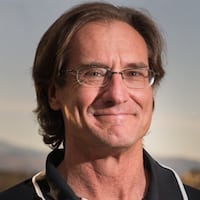A young Texas mathematical whiz figured out lunar orbital trajectories — and became the first woman to work in Mission Control. Her mission? Apollo.
Poppy Northcutt understands what all the fuss is about — and loves every minute of it. Finally, five decades after her precise calculations enabled nine teams of Apollo astronauts to orbit the moon and return safely to earth (six teams walked; three worked in orbit), her huge role in mankind’s greatest voyage to date is chronicled in chronicled in Apollo: Missions to the Moon, on the NatGeo Channel in July.
In a decade that has brought out the huge roles women played in our space program, highlighted by the movie Hidden Figures and the first episode of the CNN series 1969, Poppy has become a minor celebrity. While the computresses in Hidden Figures actually started in the mid-1940s (the movie focuses on the late 1950s and early 1960s), Poppy went to work for TRW in 1965. Soon, the mathematical and engineering whiz had a new assignment: the fledgling Apollo program.
“I, of course, was aware of computresses at NASA, but I worked in a different capacity. I was on the (Apollo) project from the beginning, to develop a return-to-earth capacity, to figure out the trajectory maneuvers to get a spacecraft from the moon to earth with three astronauts aboard,” she said.
In Apollo, director Tom Jennings became the perfect person to present Polly’s story, since Apollo 8 —highlighted by the immortal Christmas Eve 1968 live telecast from lunar orbit — is also Jennings’ favorite childhood memory. “Her story is not only important because of what she did — helped figure out how to get us back from the moon — but because of the legacy. Every girl and young woman entering aerospace, or any STEM program, can watch this movie and see who one of the true godmothers of STEM-in-action is. Polly will never say that, but that’s the case. It’s also the case that she’s one of the unsung heroes of our space program.”
Currently the Texas chapter president of the National Organization for Women, Poppy still cuts a tall, stately swath through any room she enters. Her brilliant mind and sharp-tongued wit speak of a woman who held her own in the formerly men’s-only environment of Mission Control, but also one so committed to getting men to the moon and back home that she routinely worked 80 to 100-hour weeks — as did everyone in the 1960s and early 1970s.
“I would do simulations before 8 a.m., then go across the street for 4 to 6 hours a day, as we were still de-bugging the program. Then work some more on it. We’d already blown through several ‘mission kill’ deadlines, things that would stop a program dead today. Then, it was like, ‘We’re flying 8. By God, we’re getting up there.’ That was the feeling — we are going, so we damn well better be ready.”
Innovation & Tech Today: You started working with TRW, then you were assigned to NASA for the Apollo space program. Then the Apollo 1 launch pad fire happened. How did we get from a disaster that would’ve shut down the program for years if it happened now, to lunar orbit in less than two years?
Poppy Northcutt: Apollo 8 was accelerated; we first heard rumors of it in the summer of 1968. This was before Apollo 7 even launched, an earth-orbit mission, our first since the Apollo 1 fire. We hadn’t even proven we could launch an Apollo capsule with three men into earth orbit – let alone the moon. So, the rumors were initially laughable to me. We were considered a critical program – if you do go to the moon, you want to come back – and we weren’t ready. We weren’t tested.
In August [1968], they made it official: We’re going to fly Apollo 8 in December. We had tremendous pressure. We had to finish the testing. Plus, the retrofire officers at NASA had never done return-to-earth maneuvers. It’s a whole different game to come back from the moon, as opposed to returning to earth from our own orbit.
Then one day, someone came to me and said, “You’re going to move over and help out in Mission Control.” I just thought, “Wow!” I was the only woman there, and what a time — to be part of the first mission to try to go to the Moon.
I&T Today: What was the feeling in Mission Control when Apollo 8 astronauts Frank Borman, Bill Anders, and Jim Lovell flew to the moon in December 1968?
Poppy Northcutt: Exhilirating. Stressful. Really stressful at times. We at TRW had created a rock-solid return-to-earth trajectory program with IBM’s computers, and it was well-tested. So we were confident. However, the astronauts could not configure their own return on board, in case something went wrong. It all had to be read up to them. Apollo 8 was particularly grueling, because every time they lost contact on the other side [of the moon], when they came into radio range again, they’d have to give guidance data to Mission Control, then we’d have to give them a return trajectory for the next time they were behind the moon — or, if there was a problem, abort the mission immediately and get them right home. We also had to project a second and third orbit ahead, because they had no on-board capacity.
The most stressful time was that first loss of communication. They were going to do a big orbital maneuver they had never done before, a lunar orbit insertion, with no communication — on the back side of the moon. As they came back around that first time, there was a big clock in Mission Control — the countdown to radio acquisition. We didn’t hear anything. They were late. They weren’t out on time. You could hear the CapCom calling out to them. No one was breathing, not a breath being taken in that place.
Then they finally answered.
The reason they were late was because there were landmass concentrations on the moon – mountains – that had never been mapped, so their orbit was a little disturbed. That was the most nerve-wracking thing. If they had over-burned or under-burned — either one — we might have to go into an emergency situation.
I&T Today: Give us a sense of how precise your calculations and their execution had to be.
Poppy Northcutt: Well, when I started, there were still engineers walking around with slide rules, doing open mental calculations and desk calculations. We had computers, but the real intensity of computers was just coming into being. And we needed all we could get. That computer development — that first use of what we call ‘big data’ today — got us to the moon and back.
You could not come back to earth from the moon without high-speed computers. The precision was so high, and the distances so great, that a tiny error when it’s time to come back to earth — a millimeter off, a hundredth of a millimeter — meant you could miss earth re-entry entirely. If you’re orbiting the earth, and you slow down the vehicle, eventually, you will come back to earth. Maybe not through the re-entry corridor you want, the place you want, or even alive, but you will come back at some point… You can’t say that about coming back from the moon.
I&T Today: You also worked to bring the astronauts home from the Apollo 13 service module explosion. From your perspective, what was the definition of a successful mission?
Poppy Northcutt: I considered it a successful mission when we brought our boys back alive. So did everyone else at NASA. Did I have thoughts about us losing people in space? Of course. We all did. Especially on Apollo 13. To have this explosion on the way out, on a non free-return trajectory…
I&T Today: Which is?
Poppy Northcutt: A free return means the spacecraft will automatically fly around the back of the moon and return to earth on a computer program. Apollo 13 was not on that trajectory; it was the first mission we did that was non-free return, to give the astronauts options in case something went wrong on either our end or theirs. So they were a little out of the (earth re-entry) angle. The maneuver they did, with a ruined spacecraft, put them on free return. We did the free return to get them back here. We didn’t know if they would be dead or alive, but we had to get them home to find out what the hell happened.
I&T Today: How do you view the Apollo 13 mission today?
Poppy Northcutt: Some people saw that as a mission failure. I saw it as a mission success. To me, the most successful mission is when they get back alive. It also showed we could recover from something horrible in space, and bring our boys back alive. That was an immense achievement.
I&T Today: It’s now 50 years later, we’re celebrating the historic achievement of Apollo 11 and the Apollo space program, and you’re telling the story again. What do you remember most about the work atmosphere, the sense of what you were trying to achieve?
Poppy Northcutt: We felt everything you feel when you’re doing something that has potential earth-shattering consequences — pride, purpose, a sense of urgency, the sense of something bigger than ourselves. All of those things. Think about it: my job was important, yes, but I had one of 400,000 important jobs. They all had to come together. So I’d think that everyone alive out of those 400,000 space program workers is feeling a lot of pride right now. We had a saying: Failure is impossible. I’d love to see more of that sense in the way we work today.










